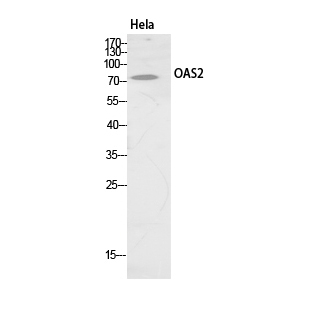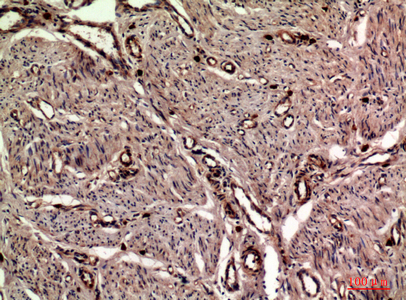OAS2 Polyclonal Antibody
- SPECIFICATION
- CITATIONS
- PROTOCOLS
- BACKGROUND

Application
| WB, IHC-P |
|---|---|
| Primary Accession | P29728 |
| Reactivity | Human |
| Host | Rabbit |
| Clonality | Polyclonal |
| Calculated MW | 82431 Da |
| Gene ID | 4939 |
|---|---|
| Other Names | OAS2; 2'-5'-oligoadenylate synthase 2; (2-5')oligo(A) synthase 2; 2-5A synthase 2; p69 OAS / p71 OAS; p69OAS / p71OAS |
| Dilution | WB~~Western Blot: 1/500 - 1/2000. IHC-p: 1:100-1:300. ELISA: 1/20000. Not yet tested in other applications. IHC-P~~N/A |
| Format | Liquid in PBS containing 50% glycerol, 0.5% BSA and 0.09% (W/V) sodium azide. |
| Storage Conditions | -20℃ |
| Name | OAS2 (HGNC:8087) |
|---|---|
| Function | Interferon-induced, dsRNA-activated antiviral enzyme which plays a critical role in cellular innate antiviral response (PubMed:10464285, PubMed:9880569). Activated by detection of double stranded RNA (dsRNA): polymerizes higher oligomers of 2'-5'- oligoadenylates (2-5A) from ATP which then bind to the inactive monomeric form of ribonuclease L (RNASEL) leading to its dimerization and subsequent activation (PubMed:10464285, PubMed:11682059, PubMed:9880569). Activation of RNASEL leads to degradation of cellular as well as viral RNA, resulting in the inhibition of protein synthesis, thus terminating viral replication (PubMed:10464285, PubMed:9880569). Can mediate the antiviral effect via the classical RNASEL-dependent pathway or an alternative antiviral pathway independent of RNASEL (PubMed:21142819). In addition, it may also play a role in other cellular processes such as apoptosis, cell growth, differentiation and gene regulation (PubMed:21142819). May act as a negative regulator of lactation, stopping lactation in virally infected mammary gland lobules, thereby preventing transmission of viruses to neonates (By similarity). Non-infected lobules would not be affected, allowing efficient pup feeding during infection (By similarity). |
| Cellular Location | Cytoplasm. Cytoplasm, perinuclear region |

Thousands of laboratories across the world have published research that depended on the performance of antibodies from Abcepta to advance their research. Check out links to articles that cite our products in major peer-reviewed journals, organized by research category.
info@abcepta.com, and receive a free "I Love Antibodies" mug.
Provided below are standard protocols that you may find useful for product applications.
Background
Interferon-induced, dsRNA-activated antiviral enzyme which plays a critical role in cellular innate antiviral response (PubMed:10464285, PubMed:9880569). Activated by detection of double stranded RNA (dsRNA): polymerizes higher oligomers of 2'- 5'-oligoadenylates (2-5A) from ATP which then bind to the inactive monomeric form of ribonuclease L (RNASEL) leading to its dimerization and subsequent activation (PubMed:10464285, PubMed:9880569, PubMed:11682059). Activation of RNASEL leads to degradation of cellular as well as viral RNA, resulting in the inhibition of protein synthesis, thus terminating viral replication (PubMed:10464285, PubMed:9880569). Can mediate the antiviral effect via the classical RNASEL-dependent pathway or an alternative antiviral pathway independent of RNASEL (PubMed:21142819). In addition, it may also play a role in other cellular processes such as apoptosis, cell growth, differentiation and gene regulation (PubMed:21142819). May act as a negative regulator of lactation, stopping lactation in virally infected mammary gland lobules, thereby preventing transmission of viruses to neonates (By similarity). Non-infected lobules would not be affected, allowing efficient pup feeding during infection (By similarity).
If you have used an Abcepta product and would like to share how it has performed, please click on the "Submit Review" button and provide the requested information. Our staff will examine and post your review and contact you if needed.
If you have any additional inquiries please email technical services at tech@abcepta.com.













 Foundational characteristics of cancer include proliferation, angiogenesis, migration, evasion of apoptosis, and cellular immortality. Find key markers for these cellular processes and antibodies to detect them.
Foundational characteristics of cancer include proliferation, angiogenesis, migration, evasion of apoptosis, and cellular immortality. Find key markers for these cellular processes and antibodies to detect them. The SUMOplot™ Analysis Program predicts and scores sumoylation sites in your protein. SUMOylation is a post-translational modification involved in various cellular processes, such as nuclear-cytosolic transport, transcriptional regulation, apoptosis, protein stability, response to stress, and progression through the cell cycle.
The SUMOplot™ Analysis Program predicts and scores sumoylation sites in your protein. SUMOylation is a post-translational modification involved in various cellular processes, such as nuclear-cytosolic transport, transcriptional regulation, apoptosis, protein stability, response to stress, and progression through the cell cycle. The Autophagy Receptor Motif Plotter predicts and scores autophagy receptor binding sites in your protein. Identifying proteins connected to this pathway is critical to understanding the role of autophagy in physiological as well as pathological processes such as development, differentiation, neurodegenerative diseases, stress, infection, and cancer.
The Autophagy Receptor Motif Plotter predicts and scores autophagy receptor binding sites in your protein. Identifying proteins connected to this pathway is critical to understanding the role of autophagy in physiological as well as pathological processes such as development, differentiation, neurodegenerative diseases, stress, infection, and cancer.

.jpg)


